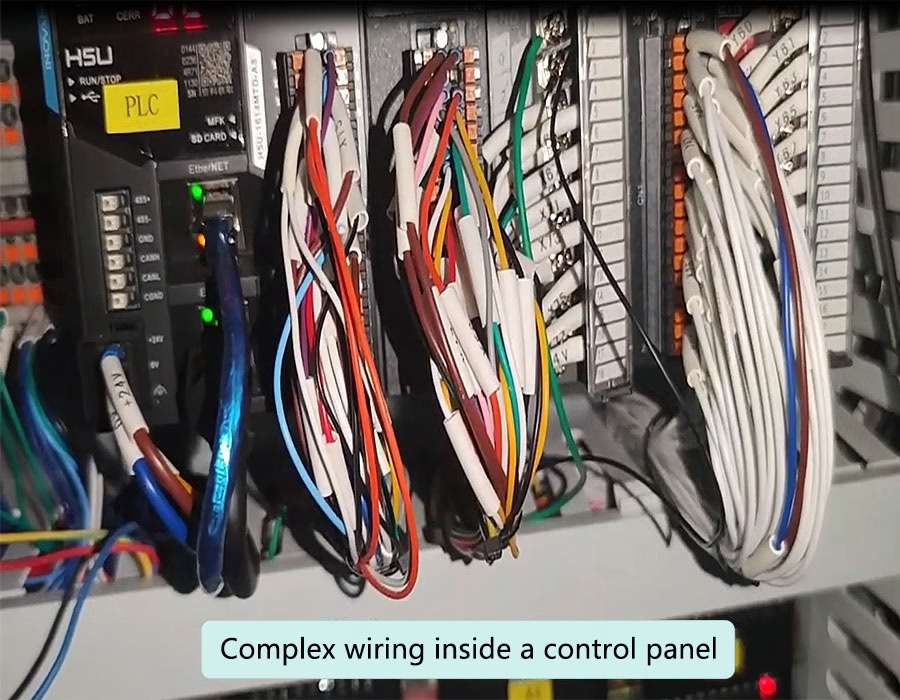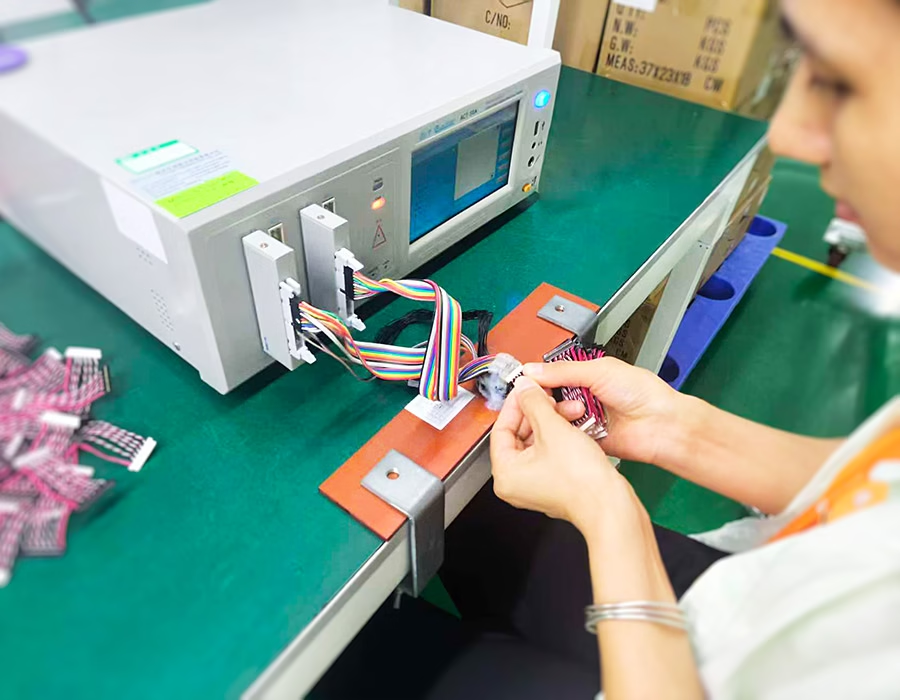Robot wire harnesses are the backbone of any automated system, carrying power and signals through every joint of a machine. Because robots operate in demanding environments (such as heat, vibration, or motion), even a minor flaw in a harness can trigger a significant failure. In fact, studies show about 70% of harness failures start as microscopic production flaws (bad crimps, insulation nicks, etc.). Rigorous testing and quality control (QC) catch those hidden defects early – on the bench rather than on the factory floor.
By scrutinizing each harness, manufacturers ensure safety and reliability, thereby preventing future recalls and downtime.
Key Testing Methods for Wire Harnesses
The QC process layers several checks. First, perform a visual inspection for obvious issues, such as routing, labels, insulation damage, or missing parts. After assembly, electrical tests verify each circuit. For example, continuity testing ensures that every conductor connects end-to-end (with no open circuits), while Hi-Pot (high-voltage) testing applies voltage to detect insulation breakdowns. Contact-resistance testers can also validate that crimps and solder joints are sound.

Automated test benches can verify continuity and insulation on each circuit, catching faults early. These stages often use automatic testers and fixtures. On a test bench, each harness is mated to a fixture that applies continuity checks and high-voltage stress, quickly pinpointing any mis-wiring or shorts. Finally, a functional test may power up the harness (or plug it into connectors) to simulate real-world use, ensuring everything works end-to-end.
Typical QC steps (used at each stage) include:
- Visual inspection: Check wire routing, labels, and insulation for visible defects.
- Continuity test: Confirm that each circuit is complete, with no open circuits.
- Insulation/Hi-Pot test: Apply high voltage between conductors to ensure insulation integrity (no breakdown).
- Crimp/pull test: Measure the pull force on terminals to verify that crimps and solder joints remain secure.
- Functional test: Mate connectors and power the harness under a controlled load to validate real-world operation.
These methods complement one another. For instance, automated cable testers can detect wiring or insulation faults within seconds, significantly reducing human error. By employing specialised test fixtures and computerised testers, wiring or insulation defects can be identified at an early stage, thereby ensuring reliability. In practice, each new wiring harness or batch of products typically undergoes 100% continuity testing and dielectric strength testing before being released for production.
Mechanical and Environmental Stress Testing
Once electrical integrity is confirmed, harnesses must endure real-world stresses. Robot cables twist, bend, and vibrate constantly in use. Specialized mechanical tests simulate these forces: for example, a flex (bend) test repeatedly bends the assembly to expose weak crimps or wire breakage. Vibration tables shake harnesses to ensure connectors stay seated under continuous jarring.

In practice, we also subject each assembly to bending, vibration, and climate tests. Environmental tests follow suit. Harnesses are cycled through extreme temperatures (e.g., –40°C to +125°C) to verify that materials won’t crack or shrink. Salt-spray or immersion tests verify the waterproofing or corrosion resistance of materials. Passing these conditions confirms that a cable harness won’t fail in the field.
Robotic applications often have extra durability standards. For instance, drag-chain tests may flex a cable millions of cycles (often 5–20 million bends) without damage. In practice, robot harnesses utilize high-flex cable designs (usually featuring orange jackets) and finely stranded wires to withstand this. By the time a harness leaves the factory, it has proven itself against both electrical checks and tough mechanical/environmental challenges.
Standards and Certifications
Quality harness manufacturing involves adhering to proven standards. A key benchmark is IPC/WHMA-A-620 – the global workmanship standard for cable/harness assemblies. Many robot OEMs train their assemblers to meet the IPC-A-620 standard, ensuring that every crimp, solder, and inspection adheres to a consistent quality level. Similarly, modern factories typically operate under a certified quality system (ISO 9001 or industry-specific QMS) to ensure disciplined processes.
On the components side, wires and connectors usually carry safety approvals. In North America, UL and CSA certification on wires guarantees they passed flame and voltage tests. In Europe, CE marking and RoHS compliance are mandatory, meaning harness materials are free from restricted substances. Choosing UL/CSA-approved cables and CE-rated connectors is essentially buying into proven safety standards.
By combining these certifications with internal quality control testing, manufacturers ensure consistent outcomes. Meeting standards such as IPC-A-620 and ISO 9001 provides a practical means of guaranteeing quality in wiring harness production. In short, standardized processes and certification systems deliver the reliability engineers require.
Cost vs. Quality: The ROI of Testing
Reasonable quality control adds some cost up front, but it pays off big time. Skipping tests might save a few dollars per harness today, but a single in-field failure can cost orders of magnitude more (think equipment damage, downtime, or recall expenses). In many industries (like aerospace or automotive), the cost of a warranty repair or shutdown is so high that even thorough QC is a bargain.
Investing in 100% electrical tests, pull testing, and stress screening typically pays for itself by preventing problems. One study found manual assembly had ~0.5–1.2% bad crimps, but automated crimping cut that to 0.03–0.08%. Over thousands of harnesses, catching those defects before shipment avoids field failures, preserves brand reputation, and keeps systems running longer. In other words, every dollar spent on testing often yields many more dollars in savings through warranty and reliability improvements.
Standard Tests at a Glance
| Test Category | Purpose | Typical Checks |
|---|---|---|
| Electrical | Verify wiring and insulation integrity | Continuity tests; Hi-Pot/dielectric tests |
| Mechanical | Ensure harness withstands stress | Flex/bend tests; tensile pull tests; vibration |
| Environmental | Assess durability under harsh conditions | Thermal cycling; salt-spray; humidity; waterproof (IP) testing |
| Functional | Confirm overall operation | Connector mating; short-circuit checks; live end-to-end tests |
Table: Typical wire harness test categories, purposes, and examples (based on industrial harness QC practices).
FAQs
A: Almost every harness gets an electrical continuity check (no open circuits) and an insulation integrity test (Hi-Pot). Technicians also perform mechanical checks—bending/flex and pull tests—to verify the strength of crimps and wires. Finally, a functional (end-to-end) test is typically run by powering the harness or plugging it into test fixtures, ensuring that the harness functions properly under load. Many factories also do visual and 100% pull/crimp tests in line.
A: Because finding defects early is far cheaper than fixing failures later. Catching an open circuit on the production line might cost a minute of work, but the same open circuit in a finished robot could cause a catastrophic error or recall. Over time, rigorous QC leads to far fewer warranty repairs and more uptime, which more than justifies the upfront testing cost.
A: Key standards include IPC/WHMA-A-620 (assembly workmanship) and ISO 9001 (quality management). Also, ensure that the wires and connectors are UL/CSA approved (for North America) or CE/RoHS compliant (for EU). Meeting these benchmarks means the harness was made with proper methods and materials, resulting in consistent and reliable performance.
Summarize
High-quality robot wire harnesses are achieved by combining standardized processes, component certifications, and multi-stage testing. By inspecting visually, testing electrically, and stressing mechanically, manufacturers can deliver harnesses that behave like new robots: predictable, durable, and ready for action.
.avif)
Sam Wu is the Marketing Manager at Romtronic, holding a degree in Mechatronics. With 12 years of experience in sales within the electronic wiring harness industry, he manages marketing efforts across Europe. An expert in cable assembly, wiring harnesses, and advanced connectivity solutions, Sam simplifies complex technologies, offering clear, actionable advice to help you confidently navigate your electrical projects.


